
The Spanish gallery, also called Spanish museum was a gallery of Spanish painting created by French King Louis Philippe I in 1838, shown in the Louvre, then dismantled in 1853. [1]

The Spanish gallery, also called Spanish museum was a gallery of Spanish painting created by French King Louis Philippe I in 1838, shown in the Louvre, then dismantled in 1853. [1]
Until the French Revolution, Spanish art was seldom shown or known in France. it appeared at the Louvre with the Napoleonic Wars and the looting politics of Vivant Denon. However, stolen art pieces were given back by France after the Congress of Vienna (1814–1815).
Louis Philippe decided in 1835 to found a Spanish painting gallery in the Louvre. He had several motivations:
Beginning in 1810, French occupation and repression in Spain made it highly unstable. The secularization of religious orders facilitated the selling of their art pieces outside of the Spanish territory.
In 1835, he founded an "artistic mission" directed by Baron Isidore Taylor, which was in charge of constituting quickly a vast collection of Spanish paintings. [2] [3] Taylor acquired a huge collection of hundreds of paintings from primitive paintings to the Spanish Golden Age. Many of the paintings he acquired were unknown from the public because they came from religious collections.
The Spanish Gallery opened to the public on 1838/01/07, in five rooms on the first floor of the Louvre Cour Carrée's East (Colonnade) Wing. [4] The opening was accompanied by a lot of Royal marketing and publicity. Louis Philippe stressed the point that the collection was acquired on his own founds. The collection counted for example 81 Zurbaran, 39 Murillo, 28 Ribera, 23 Cano, and 19 Velázquez. Many paintings attracted the admiration of the public.
However, the collection, which counted 450 paintings, was criticized for its inconsistency. Taylor sent "en masse" the paintings, without any preliminary selection, and nobody in the Louvre had the required expertise to operate this selection. Masters as Murillo and Zurbaran were shown alongside much smaller artists.

After the death of Louis Philippe, the collection was dismantled in London, from 6 to 8 May 1853, during an auction in Christie's. [5] Only one painting was forgotten in the reserves and remained in the Louvre (The deploration of Christ by Jaume Huguet). One of the painting came back later to the Louvre in 1908: "Le Christ en croix adoré par deux donateurs" from El Greco, bought from the Prades town for 25000 francs. Nowadays only these two paintings from the initial collection are shown in the Louvre. [6]
This collection was seen by many artists and intellectuals of the time and influenced them. Édouard Manet wrote to Charles Baudelaire, concerning Velazquez, in a letter from the 14 September 1865: "he is the greatest painter of all times. [7] [8]

The Louvre, or the Louvre Museum, is a national art museum in Paris, France. It is located on the Right Bank of the Seine in the city's 1st arrondissement and home to some of the most canonical works of Western art, including the Mona Lisa,Venus de Milo, and Winged Victory. The museum is housed in the Louvre Palace, originally built in the late 12th to 13th century under Philip II. Remnants of the Medieval Louvre fortress are visible in the basement of the museum. Due to urban expansion, the fortress eventually lost its defensive function, and in 1546 Francis I converted it into the primary residence of the French kings.

Jean-Baptiste Regnault was a French painter.
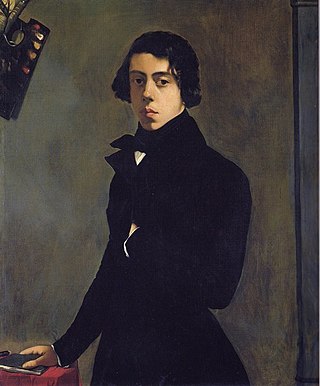
Théodore Chassériau was a Dominican-born French Romantic painter noted for his portraits, historical and religious paintings, allegorical murals, and Orientalist images inspired by his travels to Algeria. Early in his career he painted in a Neoclassical style close to that of his teacher Jean-Auguste-Dominique Ingres, but in his later works he was strongly influenced by the Romantic style of Eugène Delacroix. He was a prolific draftsman, and made a suite of prints to illustrate Shakespeare's Othello. The portrait he painted at the age of 15 of Prosper Marilhat makes Chassériau the youngest painter exhibited at the Louvre museum.
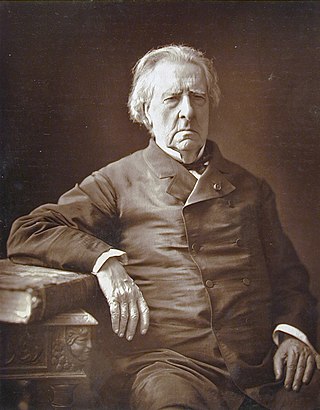
Isidore Justin Séverin, Baron Taylor was a French dramatist, artist, and philanthropist. He was closely associated with the development of French theatre, a pioneer of Romanticism, and also a noted traveller.

El Greco, 1541 – April 7, 1614) was a prominent painter, sculptor and architect of the Spanish Renaissance, whose dramatic and expressionistic style was met with puzzlement by his contemporaries but found appreciation in the 20th century.
Michel Laclotte was a French art historian and museum director, specialising in 14th and 15th century Italian and French painting.

Antoni Taulé is a Spanish painter, architect, and performer. A street artist during the sixties, his art has been labelled as part of hyperrealism and a representative of the “new figurative” movement. He paints classical empty buildings and interiors: ballrooms, office receptions, halls of the Louvre museum, chambers of the Prado, the Palace of Versailles, monumental spaces that fuse reality and fiction under a fleeting atmosphere of light.
The building is actually just like a person. It has a heart, lungs, a nervous system, intestines, and eyes ... I am fascinated with what one can see, with the reason why does one look at it or avoid looking, and how one reflects upon what he sees. In one word my work is about how a man functions.

Louis La Caze was a successful French physician and collector of paintings whose bequest of 583 paintings to the Musée du Louvre was one of the largest the museum has ever received. Among the paintings, the most famous are likely to be Pierrot by Antoine Watteau, or Rembrandt's Bathsheba at Her Bath.
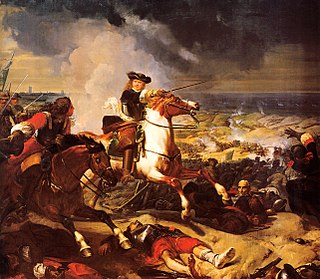
Charles-Philippe Larivière was a French academic painter and lithographer.

Henri Richelet was a French painter.

The Fifer or Young Flautist is a painting by French painter Édouard Manet, made in 1866. It is usually kept in the Musée d'Orsay, Paris.

Didier Ottinger, born in Nancy in 1957, is a French museum curator, art critic and author. He is known for organizing exhibitions and publishing books on modern and contemporary painting. He is now assistant director of the Centre Pompidou at the Musée national d'art moderne in Paris.

Agnès Thurnauer is a French-Swiss contemporary artist. Primarily a painter, she also works with a number of other media and techniques.
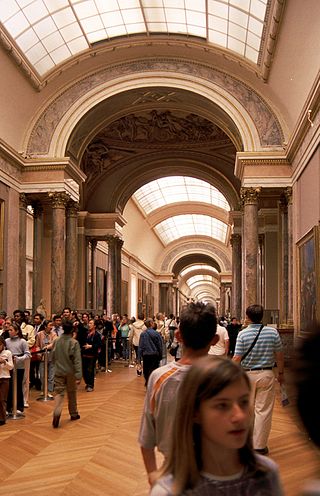
The Grande Galerie, in the past also known as the Galerie du Bord de l'Eau, is a wing of the Louvre Palace, perhaps more properly referred to as the Aile de la Grande Galerie, since it houses the longest and largest room of the museum, also referred to as the Grande Galerie, one of the museum's most iconic spaces.
Jeannine Baticle was a French art historian, and curator, She was the Honorary Deputy Director and Chief Curator of the Department of Paintings of the Louvre Museum, and a specialist in Spanish painting.

Herman Braun-Vega was a Peruvian painter and artist.

Portrait of Marguerite de Conflans is a c.1876 oval oil on canvas portrait by the French painter Édouard Manet. It is owned by the Musée d’Orsay, though it is on display in the red salon at the Musée des Augustins in Toulouse. Like A Bar at the Folies-Bergère, the work mimics Ingres in its use of a mirror to show the figure from several angles, a motif rarely used by Manet.

Charles-Caius Renoux was a French painter, lithographer, and illustrator. He first achieved success with paintings of medieval churches, particularly the ruins of cloisters and monasteries destroyed during the French Revolution, works for which he is still best known. Renoux also painted landscapes, large-scale battle scenes, and historical subjects, works which uniquely prepared him for the final phase of his career, the creation of spectacular dioramas, the "moving pictures" of the era. He also taught at the École des Beaux-Arts in Paris; his notable students included Narcisse Berchère and Hector Hanoteau.

The Musée de l'Histoire de France is a museum that was created by King Louis Philippe I in the Palace of Versailles and opened in 1837. At the time, it represented an ambitious project of national reconciliation between the hitherto competing narratives of the French monarchy and the French Revolution, to which Louis-Philippe devoted significant personal attention. Whereas it gradually faded in importance as a museum in the later 19th century, its lavish historicist decoration remains a major exemplar of the art of France's July Monarchy.
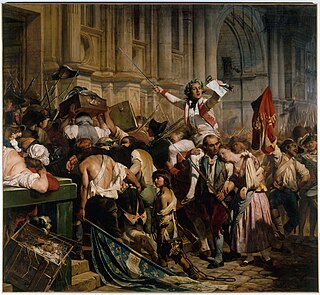
The Victors of the Bastille in Front of the Hôtel de Ville is a large oil on canvas painting by French painter Paul Delaroche, from c. 1835. it is held in the Petit Palais, in Paris.
Louis Philippe le charge en 1835 d'acquérir des tableaux en Espagne pour permettre l'ouverture de la Galerie espagnole du Musée du Louvre en 1838.
En el mismo año se abrió en París la Galería Española de Luis Felipe, con unas cuatrocientas obras españolas. Hasta su venta final en 1853, aquella colección ejerció una influencia considerable sobre el gusto artístico de Francia, aunque también recibió críticas acerbas en la prensa. Gran parte del texto de Taylor sobre el Real Museo de Madrid constituye realmente una vindicación de la Galería Española de París.
La collection de Louis-Philippe, acquise grâce au zèle du baron Taylor, rendue au roi déchu par une République trop vertueuse, a joué un rôle majeur dans l'histoire de l'art
A son ami Baudelaire, Manet écrira : « C'est le plus grand peintre qu'il y ait jamais eu. »